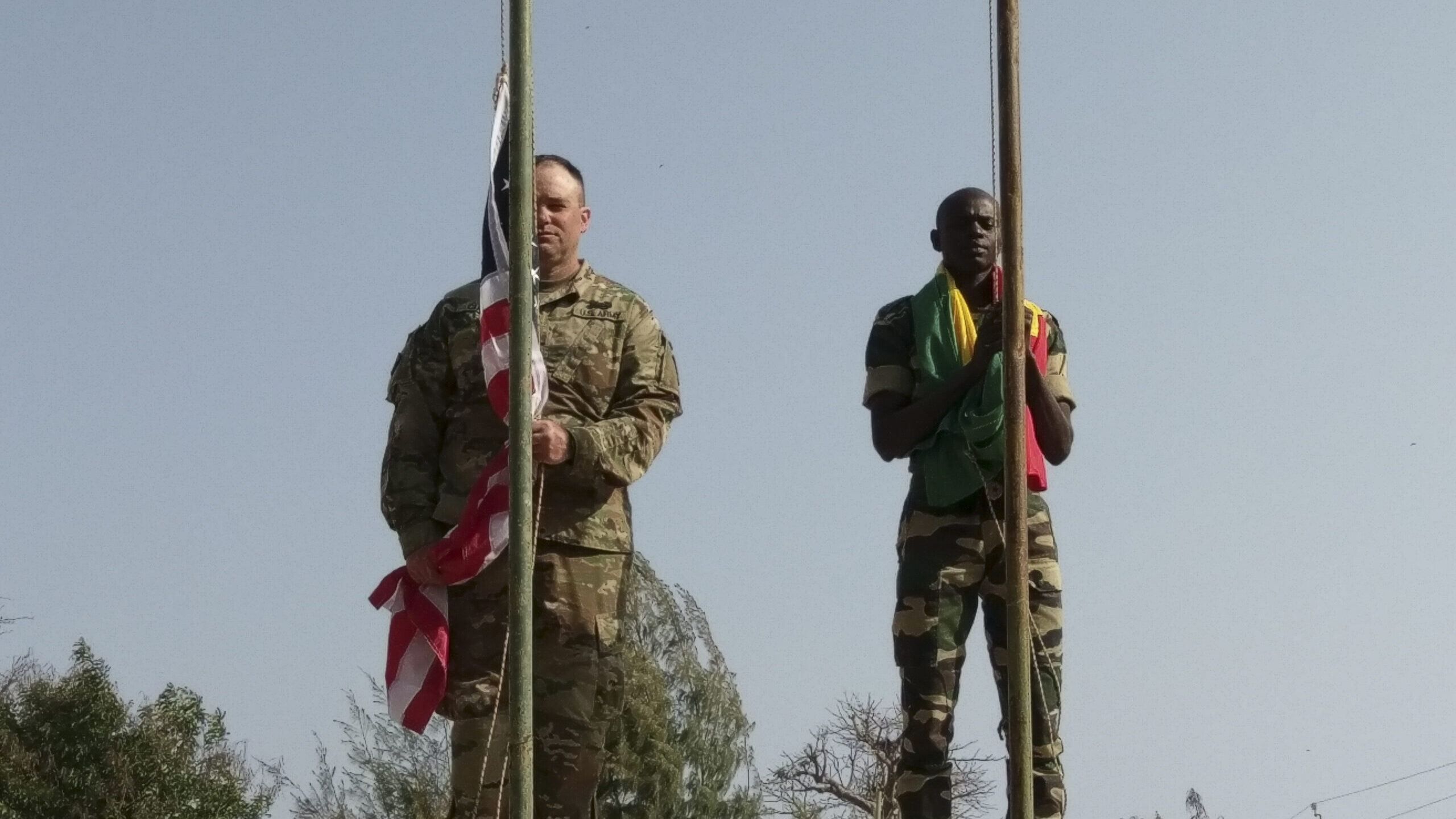
Sgt. Jack Curtis prepares to raise the American Flag during a ceremony honoring the partnership between the Vermont National Guard and Senegal, April 24, 2018, Centre D’Entrainment Tactique N7, Senegal. (U.S. Army National Guard Photograph by Sgt. Jeremy Nadeau)
The National Guard’s State Partnership Program connects various state units with nations around the globe. It’s an interesting Pentagon effort, but US Army Lt. Col. Malcolm Warbrick argues in the following piece it has never received the kind of integration into national planning that it should. That, Warbrick notes, should change in the wake of the COVID-19 pandemic.
In addition to the pivotal role the United States military plays in deterring aggression by hostile states like Russia and China, it shoulders increasing responsibility for supporting the federal response to crises like the COVID-19 pandemic and instability on the US-Mexico border. The State Partnership Program (SPP), a unique set of partnerships between State National Guards and foreign military partners, has demonstrated it can respond rapidly to the full range of demands the US military now faces.
However, the program remains an afterthought for the leaders who plan national-level responses to emerging threats. That’s a missed opportunity, especially when America needs to be strengthening its relationships abroad.
The SPP has its origins in the early years of the post-Cold War era when the United States sought to welcome former Eastern Bloc countries into NATO while recognizing Russian sensitivity to US deployments on its western border. The Department of Defense also saw that the Baltic and Eastern Bloc countries had to enhance their military capability to be ready for potential NATO membership. In 1993, the Pentagon launched the SPP to address both of these problems.
As part of the SPP, one state’s Guard unit partners with the partner’s national forces; using reserve forces, rather than the active component, was seen as a way to avoid inflaming tensions with Russia. Early pairings included Estonia-Maryland, Latvia-Michigan, and Lithuania-Pennsylvania. The initial SPP missions in Eastern Europe enhanced the capabilities, capacity, and interoperability with the United States of foreign partners, culminating in their accession to NATO.
Since then, the program has spread globally and now boasts 85 partnerships with 93 nations around the globe. The global threat of the COVID-19 pandemic presented SPP with an opportunity to demonstrate its ability to operate outside of a traditional military sphere. For instance, in December 2020, the Czech Republic-Texas-Nebraska partnerships proved critical in helping establish field hospitals before a COVID-19 resurgence. Then in November 2021, Oregon and Bangladesh trained together on disaster management during this pandemic era.
On paper, the SPP looks like the perfect tool to strengthen and support what Pentagon leaders always say is America’s key leg up on China and Russia: our network of allies and partners. And yet, despite the role this program could play to deter regional aggression from those two competitors, especially when the American public is averse to persistent conflicts, it remains missing from any first-tier US government response to national-level threats.
For example, the lack of a US vaccine diplomacy plan opened the door to the People’s Republic of China’s (PRC) influence in countries that received Chinese vaccines. For example, desperate for doses of vaccines at the onset of the pandemic, the Czech Republic turned to Texas as their SPP partner for aid– a sign of the trust leadership had built through the SPP.
If the US government had planned on working through the SPP early on, it could have led to strengthened ties; instead, the effort ran into US federal bureaucracy and the Czechs were forced to look elsewhere. These existing partnerships and the foresight to bring them into priority planning, through the SPP could have helped project goodwill that would have helped nations wait out China’s offer for American ones.
Where could new SPP agreements benefit American interests? Two come to mind.
First, consider the challenges of illegal migration and smuggling on the United States’ southern border. A multi-state SPP partnership with Mexico would facilitate the long-term military-to-military and military-to-civilian relationships that have languished under previous US-Mexico security frameworks. Specifically, SPP could utilize the post-Warsaw Pact integration model as a template for building Mexican SEDENA (Ministry of Defense) capabilities, accountability, professionalism, interoperability, and transparency. Research has shown that sustained SPP partnerships have reduced the threat of corruption and terror; helping to clean up Mexico’s border security would benefit both nations.
Second, consider the boldness of establishing a partnership with Taiwan, as part of DOD efforts to deter PRC aggression against Taiwan and reassure INDOPACOM allies and partners. This commitment would include training and command guidance. It would also seek to improve Taiwan’s military capabilities and build a robust and resilient all-volunteer reserve force, similar to the US Reserves and National Guard.
The power of the SPP is within the relationships, the knowledge sharing, and specifically with these partners — the proactive reaction to global problems. The SPP is an adaptive force with a range of capabilities suitable for a wide array of missions.
It would be a mistake for US policymakers to overlook the SPP’s strengths when Washington is struggling to meet challenges across the globe. For a fraction of the Pentagon’s budget, Congress and the DoD should help the program grow. Now is the time to invest smartly in a proven program.
US Army LTC Malcolm Warbrick is a 2021-2022 Asia-Pacific Army Fellow at the University of Washington. He is a member of the Foundation for Defense of Democracies National Security Alumni Network. The views expressed are those of the author and do not necessarily reflect the official policy or position of the Department of the Army, Department of Defense, or the US Government.
China’s new H-20 stealth bomber ‘not really’ a concern for Pentagon, says intel official
“The thing with the H-20 is when you actually look at the system design, it’s probably nowhere near as good as US LO [low observable] platforms, particularly more advanced ones that we have coming down,” said a DoD intelligence official.


























